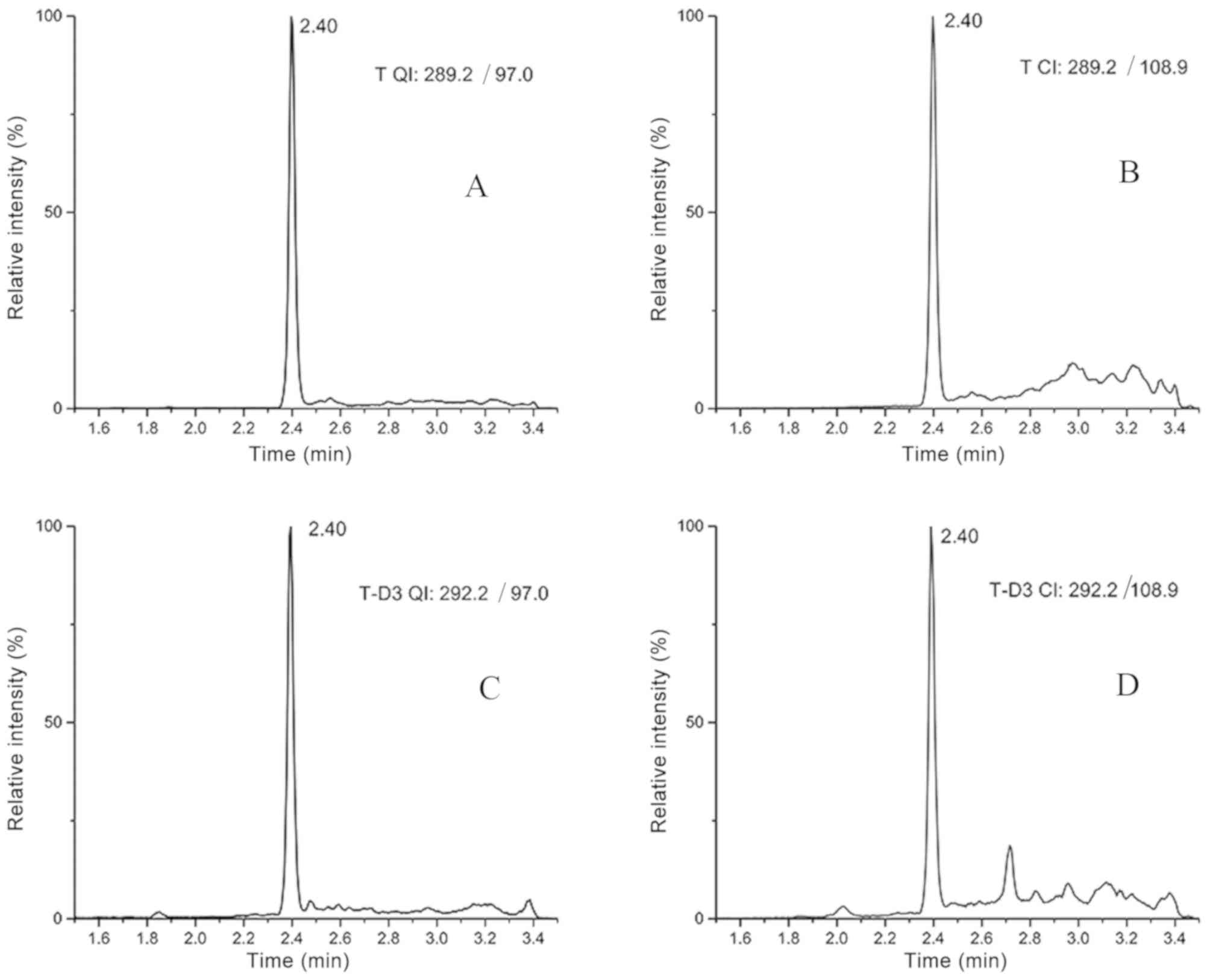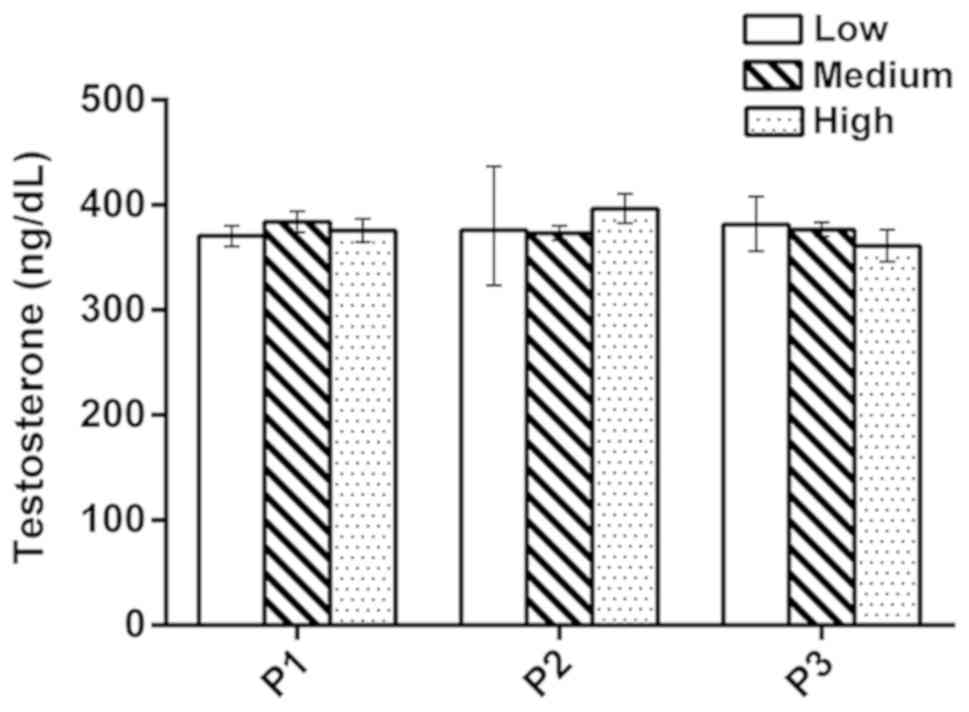|
1
|
Bhasin S, Brito JP, Cunningham GR, Hayes
FJ, Hodis HN, Matsumoto AM, Snyder PJ, Swerdloff RS, Wu FC and
Yialamas MA: Testosterone therapy in men with hypogonadism: An
endocrine society clinical practice guideline. J Clin Endocrinol
Metab. 103:1715–1744. 2018. View Article : Google Scholar : PubMed/NCBI
|
|
2
|
Kushnir MM, Rockwood AL, Roberts WL,
Pattison EG, Bunker AM, Fitzgerald RL and Meikle AW: Performance
characteristics of a novel tandem mass spectrometry assay for serum
testosterone. Clin Chem. 52:120–128. 2006. View Article : Google Scholar : PubMed/NCBI
|
|
3
|
Salonia A, Rastrelli G, Hackett G,
Seminara SB, Huhtaniemi IT, Rey RA, Hellstrom WJG, Palmert MR,
Corona G, Dohle GR, et al: Paediatric and adult-onset male
hypogonadism. Nat Rev Dis Primers. 5:382019. View Article : Google Scholar : PubMed/NCBI
|
|
4
|
Martin KA, Anderson RR, Chang RJ, Ehrmann
DA, Lobo RA, Murad MH, Pugeat MM and Rosenfield RL: Evaluation and
treatment of hirsutism in premenopausal women: An endocrine society
clinical practice guideline. J Clin Endocrinol Metab.
103:1233–1257. 2018. View Article : Google Scholar : PubMed/NCBI
|
|
5
|
La'ulu SL, Kalp KJ and Straseski JA: How
low can you go? Analytical performance of five automated
testosterone immunoassays. Clin Biochem. 58:64–71. 2018. View Article : Google Scholar : PubMed/NCBI
|
|
6
|
Cui Y, She T, Zhao H, Li J, Li L, Gao W
and Li H: Competitive light-initiated chemiluminescent assay: Using
5-α-dihydrotestosterone-BSA as competitive antigen for quantitation
of total testosterone in human sera. Anal Bioanal Chem.
411:745–754. 2019. View Article : Google Scholar : PubMed/NCBI
|
|
7
|
Taieb J, Mathian B, Millot F, Patricot MC,
Mathieu E, Queyrel N, Lacroix I, Somma-Delpero C and Boudou P:
Testosterone measured by 10 immunoassays and by isotope-dilution
gas chromatography-mass spectrometry in sera from 116 men, women,
and children. Clin Chem. 49:1381–1395. 2003. View Article : Google Scholar : PubMed/NCBI
|
|
8
|
Rosner W, Auchus RJ, Azziz R, Sluss PM and
Raff H: Position statement: Utility, limitations, and pitfalls in
measuring testosterone: An Endocrine Society position statement. J
Clin Endocrinol Metab. 92:405–413. 2007. View Article : Google Scholar : PubMed/NCBI
|
|
9
|
Wang C, Catlin DH, Demers LM, Starcevic B
and Swerdloff RS: Measurement of total serum testosterone in adult
men: Comparison of current laboratory methods versus liquid
chromatography-tandem mass spectrometry. J Clin Endocrinol Metab.
89:534–543. 2004. View Article : Google Scholar : PubMed/NCBI
|
|
10
|
Kushnir MM, Rockwood AL and Bergquist J:
Liquid chromatography-tandem mass spectrometry applications in
endocrinology. Mass Spectrom Rev. 29:480–502. 2010. View Article : Google Scholar : PubMed/NCBI
|
|
11
|
International Organization for
Standardization, . In vitro diagnostic medical devices-measurement
of quantities in samples of biological origin-metrological
traceability of values assigned to calibrators and control
Materials. ISO 17511 (Geneva). ISO. 2003.
|
|
12
|
Stanczyk FZ and Clarke NJ: Advantages and
challenges of mass spectrometry assays for steroid hormones. J
Steroid Biochem Mol Biol. 121:491–495. 2010. View Article : Google Scholar : PubMed/NCBI
|
|
13
|
Vesper HW, Bhasin S, Wang C, Tai SS, Dodge
LA, Singh RJ, Nelson J, Ohorodnik S, Clarke NJ, Salameh WA, et al:
Interlaboratory comparison study of serum total testosterone
[corrected] measurements performed by mass spectrometry methods.
Steroids. 74:498–503. 2009. View Article : Google Scholar : PubMed/NCBI
|
|
14
|
Star-Weinstock M, Williamson BL, Dey S,
Pillai S and Purkayastha S: LC-ESI-MS/MS analysis of testosterone
at sub-picogram levels using a novel derivatization reagent. Anal
Chem. 84:9310–9317. 2012. View Article : Google Scholar : PubMed/NCBI
|
|
15
|
Keski-Rahkonen P, Huhtinen K, Poutanen M
and Auriola S: Fast and sensitive liquid chromatography-mass
spectrometry assay for seven androgenic and progestagenic steroids
in human serum. J Steroid Biochem Mol Biol. 127:396–404. 2011.
View Article : Google Scholar : PubMed/NCBI
|
|
16
|
Yuan TF, Le J, Cui Y, Peng R, Wang ST and
Li Y: An LC-MS/MS analysis for seven sex hormones in serum. J Pharm
Biomed Anal. 162:34–40. 2019. View Article : Google Scholar : PubMed/NCBI
|
|
17
|
Tai SS, Xu B, Welch MJ and Phinney KW:
Development and evaluation of a candidate reference measurement
procedure for the determination of testosterone in human serum
using isotope dilution liquid chromatography/tandem mass
spectrometry. Anal Bioanal Chem. 388:1087–1094. 2007. View Article : Google Scholar : PubMed/NCBI
|
|
18
|
Lynch KL: CLSI C62-A: A New standard for
clinical mass spectrometry. Clin Chem. 62:24–29. 2016. View Article : Google Scholar : PubMed/NCBI
|
|
19
|
Guidance on the verification of
quantitative measurement procedures used in the clinical chemistry.
GL037. CNAS. 2019.
|
|
20
|
Rodriguez M and Orescan DB: Confirmation
and quantitation of selected sulfonylurea, imidazolinone, and
sulfonamide herbicides in surface water using electrospray LC/MS.
Anal Chem. 70:2710–2717. 1998. View Article : Google Scholar : PubMed/NCBI
|
|
21
|
Botelho JC, Ribera A, Cooper HC and Vesper
HW: Evaluation of an isotope dilution HPLC tandem mass spectrometry
candidate reference measurement procedure for Total 17-β estradiol
in human serum. Anal Chem. 88:11123–11129. 2016. View Article : Google Scholar : PubMed/NCBI
|
|
22
|
Matuszewski BK, Constanzer ML and
Chavez-Eng CM: Strategies for the assessment of matrix effect in
quantitative bioanalytical methods based on HPLC-MS/MS. Anal Chem.
75:3019–3030. 2003. View Article : Google Scholar : PubMed/NCBI
|
|
23
|
Yun YM, Botelho JC, Chandler DW, Katayev
A, Roberts WL, Stanczyk FZ, Vesper HW, Nakamoto JM, Garibaldi L,
Clarke NJ and Fitzgerald RL: Performance criteria for testosterone
measurements based on biological variation in adult males:
Recommendations from the partnership for the accurate testing of
hormones. Clin Chem. 58:1703–1710. 2012. View Article : Google Scholar : PubMed/NCBI
|
|
24
|
Legro RS, Schlaff WD, Diamond MP,
Coutifaris C, Casson PR, Brzyski RG, Christman GM, Trussell JC,
Krawetz SA, Snyder PJ, et al: Total testosterone assays in women
with polycystic ovary syndrome: Precision and correlation with
hirsutism. J Clin Endocrinol Metab. 95:5305–5313. 2010. View Article : Google Scholar : PubMed/NCBI
|
|
25
|
Neville D, Houghton R and Garrett S:
Efficacy of plasma phospholipid removal during sample preparation
and subsequent retention under typical UHPLC conditions.
Bioanalysis. 4:795–807. 2012. View Article : Google Scholar : PubMed/NCBI
|
















